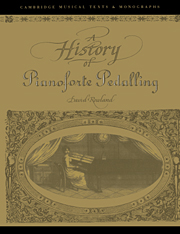Book contents
- Frontmatter
- Contents
- Acknowledgements
- List of abbreviations
- Introduction
- PART I The instruments
- PART II Pedalling and the early pianists
- PART III Pedalling after c.1800
- 7 The emergence of modern pedalling
- 8 The sustaining pedal after c.1800
- 9 Other pedals from c.1800
- APPENDIX: Chapters on pedalling from piano tutors
- Notes
- Select bibliography
- Index
8 - The sustaining pedal after c.1800
Published online by Cambridge University Press: 16 November 2009
- Frontmatter
- Contents
- Acknowledgements
- List of abbreviations
- Introduction
- PART I The instruments
- PART II Pedalling and the early pianists
- PART III Pedalling after c.1800
- 7 The emergence of modern pedalling
- 8 The sustaining pedal after c.1800
- 9 Other pedals from c.1800
- APPENDIX: Chapters on pedalling from piano tutors
- Notes
- Select bibliography
- Index
Summary
Chapter 5 showed how some pianists began to use the sustaining pedal to enhance the sonority of the piano in the closing years of the eighteenth century, not just in the higher, weaker register, but also in the middle of the instrument (see Exx. 26 and 27). This represented a change in emphasis from the effect-oriented pedalling of most eighteenth-century sources, as pianists searched for a ‘singing’ tone on the increasingly resonant piano.
A result of this search for richer sonorities was that pianists began to depress the sustaining pedal for a large proportion of the music. This ‘constant’ pedalling in turn drew attention to details of technique: how, exactly, was the pedal to be raised and depressed again at each change of harmony – especially in music where the harmonic and melodic writing was becoming more chromatic? The most important answer to this question was syncopated pedalling; the technique whereby the pedal is raised at the moment a chord or note is played, or very shortly afterwards, and depressed again immediately. It is a fundamentally different technique from that in which the pedal is depressed at the same time as the notes, as it enables the performer to produce a seamless legato, even in passages where full chords in both hands mean that all the fingers have to be taken off the notes prior to the next chord being struck.
Three refinements of syncopated pedalling appeared. Two of these have been called ‘half pedalling’ in some of the literature relating to pedalling, but they are in fact different.
- Type
- Chapter
- Information
- A History of Pianoforte Pedalling , pp. 110 - 133Publisher: Cambridge University PressPrint publication year: 1993



